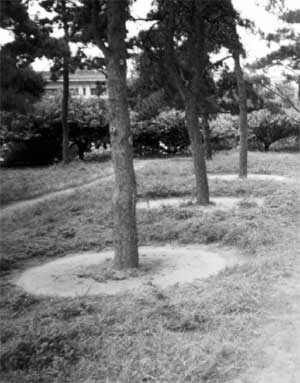Jean-philippe Gams / WuGong / 2021 / July
The Liang style BaGua Zhang circle walking
The circle walking in Bagua Zhang is probably the single most important exercise of this style. All the main current of Bagua Zhang such as Yin, Cheng, Gao and others have slightly different practice methods but all tend to agree that circle walking is the essence of this Art.
The way we practice the Liang style Bagua Zhang relies heavily on the circle walking as this is what represente at least 80% of the time spent practicing the first years. Let me explain how we go about this practice method in the Liang style.
The circle walking contains many exercises such as palms and forms. but those exercises only gets practiced after quit some time when the Ji Ben Gong (basics) are mastered. The basics are not easy to master nor is it quick. Bagua Zhang requires sacrifices and a lot of eating bitter … the first method is actually the first palm, Xia Ta Zhang, the one I’m going to write about in this article.
An example of a circle done by a Bagua practitioner
If the circle walking takes 80% of your time in the first few years of practice then Xia Ta Zhang will take 80% of the circle walking time.
Xia Ta Zhang, is done to develop inner strength, Qi and accumulate it in the Dan Tian (three fingers under your bellybutton). The body has to stay relaxed but not shallow, the footwork must be light and still heavy when in contact with the ground, the foot must stay as close as possible to the ground during the weight shifting time, and we walk the opposite way as we would in the street.
Footwork
Why I say that is because in order to stay close to the ground and develop the light skill (qing gong) we do not use the foot the same way in circle walking as we would in “street walking”. The heal must not be lifted when shifting the weight from the rear to the front and the front foot should grasp the ground (though not to hardly or you will develop Si Li (dead force)) not with the heal but more with the “toes”. This way your foot stays almost completely parallel to the floor. This serves as a great method to regain balance loss when pushed.
The feet gives you the correct angle to form the circle. In the Liang Style the inner foot goes straight but the outer foot turns with the angle that defines your circle size witch should not be more than 9 steps nor less than 7.
The size of your step is defined by the height at witch you walk. Since the knees should stay close only your lower leg should advance. The lower you are the further you can extend your leg without separating the knees.

Upper body
In Xia Ta Zhang in the Liang style, and I believe is where a difference is found in regards to other style, we do not Pivot/turn the hips. We stay straight as much as we can and only the head will tilt 45 to 35 degrees in order to see where you are going and look at your fictive opponent in the center of the circle.
The hands should form a circle from the C7 vertebra all the way down to the palms facing the ground. And a twisting motion should be performed as well inwards and downwards.
Your spine should be straight, from the L1 vertebra all the way to the top. the head is straight, the mouth is closed and breathing goes through the nose. The tongue pushes upwards to the front teeth very slightly in order for the Small Heaven circulation to go through. You should be relaxed and try to eliminate all micro tension. Empty the chest and lift up the anus, relaxe the shoulders and pull the head straight so that the Qi can sink trough.
Your eyes should fixe the horizon (in Liang style we do not practice around a three that much) straight forward, they should not move during the walk as it facilitates the mind to wander while we want it to stay focused as we try to empty it.
We always go counterclockwise at first and change every 15 / 20 minutes, and this for 2 hours everyday in order to make eight changes.
The circle walking is an art in itself and is also practiced by Taoist monks as a meditative practice combining physical exercises and mental exercises. The circle walking while being the most basic method of the style is probably also the deepest and most interesting one.